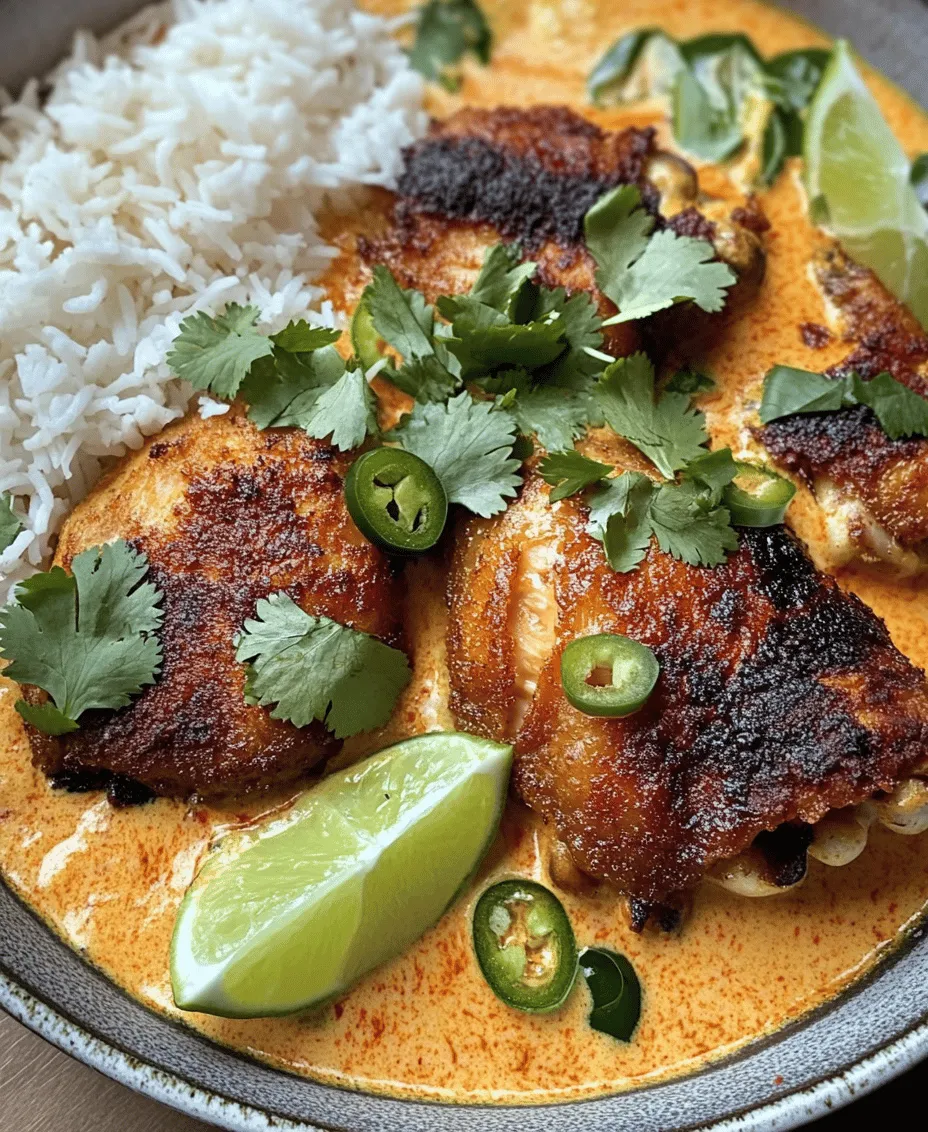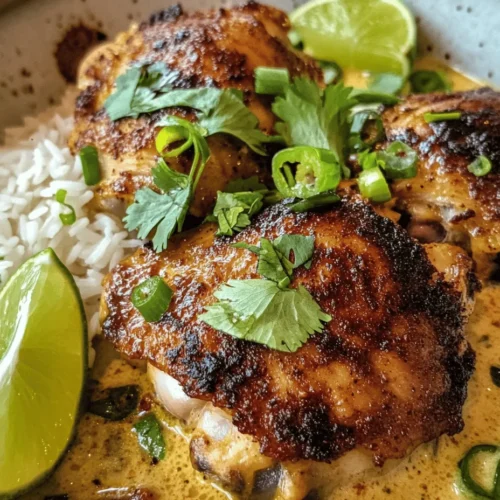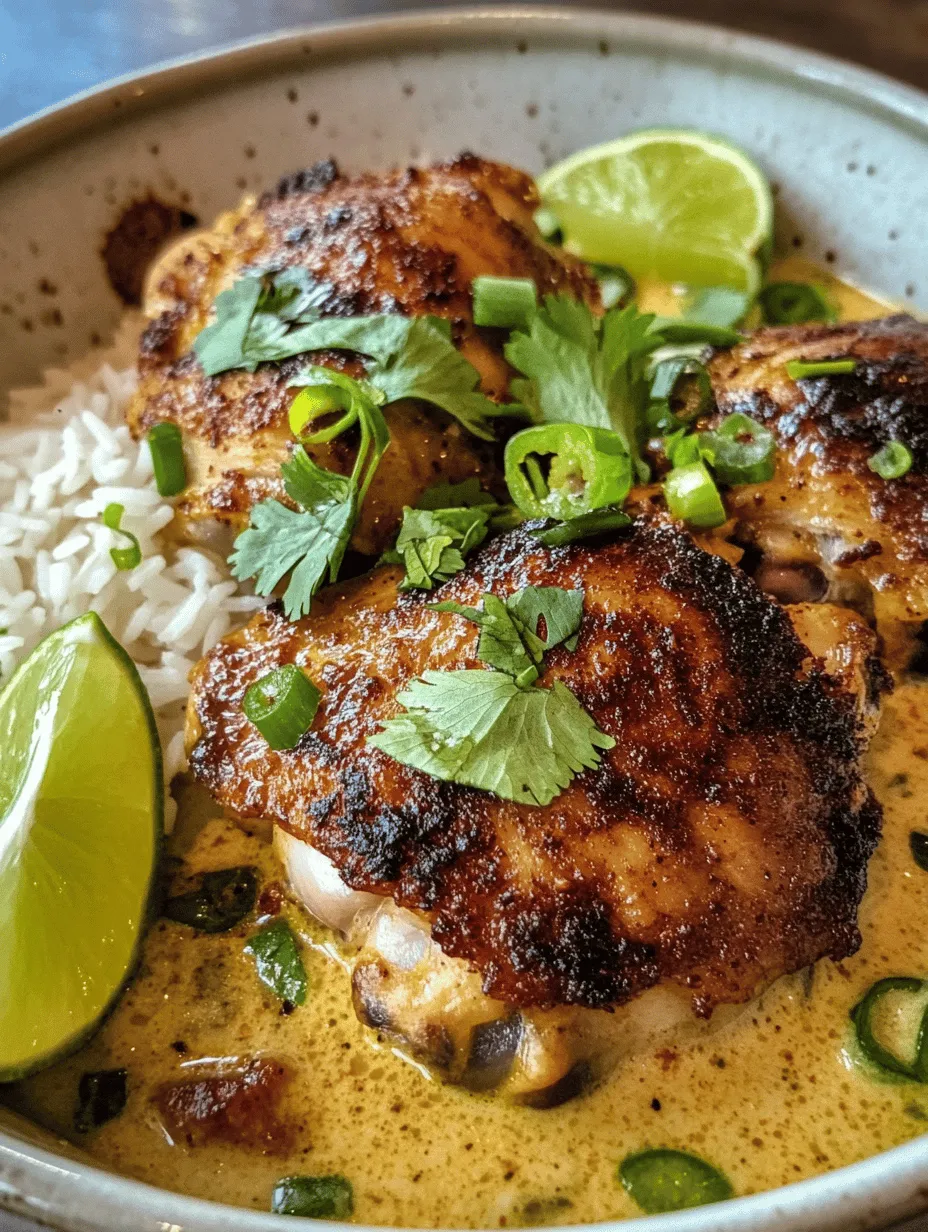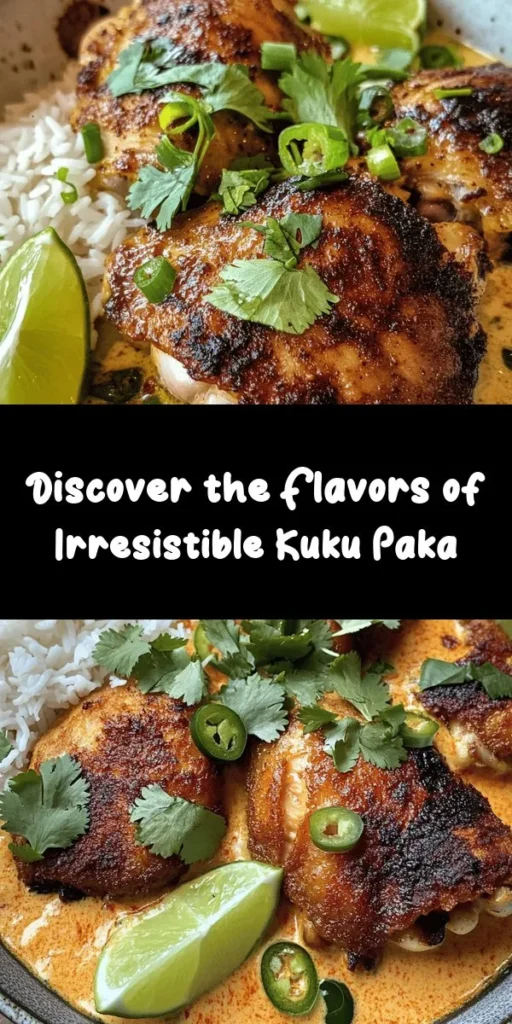Introduction to Kuku Paka: A Culinary Journey Through East Africa
Kuku Paka, a beloved dish from East Africa, particularly enjoyed in Kenya and Tanzania, embodies the rich flavors and vibrant culture of the region. This irresistible chicken curry, infused with coconut milk and aromatic spices, offers a unique combination of tenderness and zest that captures the heart of any meal. The dish not only serves as a delicious centerpiece but also reflects the diverse influences that have shaped East African cuisine over the centuries. In this article, we will delve into the origins of Kuku Paka, explore its key ingredients, and guide you step by step through the preparation process. By the end, you will not only have a delicious recipe at your fingertips but also a deeper appreciation for this East African culinary gem.
The Origins of Kuku Paka: A Cultural Insight
Exploring East African Cuisine
East African cuisine is a vibrant tapestry woven from various cultural influences and traditions. It is characterized by the use of fresh ingredients, aromatic spices, and diverse cooking techniques that reflect the region’s agricultural bounty and historical connections with trade routes. The cuisine varies from coastal to inland dishes, often showcasing the unique ingredients available in each area.
In coastal regions, such as Kenya and Tanzania, seafood plays a significant role, while inland dishes often feature meat, grains, and vegetables. The use of spices is pivotal in East African cooking, with flavors derived from indigenous herbs, as well as imported spices introduced through trade with Arab and Indian merchants. This blend results in an array of dishes that are as complex as they are delicious, with Kuku Paka standing as a quintessential example of this fusion.
Historical Background of Kuku Paka
Kuku Paka’s origins can be traced back to the blending of culinary traditions brought to East Africa by Arab and Indian traders, who arrived on the shores of the Indian Ocean centuries ago. The term “Kuku” means chicken in Swahili, while “Paka” refers to the action of applying or spreading, particularly in reference to the rich coconut sauce that coats the chicken.
The evolution of Kuku Paka reflects the cultural exchanges that have taken place in the region over the years. The dish is a testament to how local ingredients can be transformed through the influence of foreign culinary practices. The introduction of spices such as cumin, coriander, and turmeric, along with the use of coconut milk, showcases the adaptability of traditional East African cooking methods to incorporate new flavors and techniques.
Understanding the Ingredients: What Makes Kuku Paka Special
To truly appreciate Kuku Paka, it’s important to understand the key ingredients that contribute to its distinctive taste. Each component plays a vital role in crafting the dish’s signature flavor profile, ensuring that every bite is a delightful experience.
The Star of the Dish: Chicken
At the heart of Kuku Paka is chicken, and choosing the right cut is essential for achieving the best flavor and texture. Bone-in, skin-on chicken thighs are highly recommended for this recipe, as they provide moisture and richness that enhances the overall dish. The bones contribute to a deeper flavor during cooking, while the skin helps to lock in juices, resulting in tender, succulent meat.
When selecting chicken for Kuku Paka, consider opting for free-range or organic varieties whenever possible. These options not only support ethical farming practices but also tend to offer a more robust flavor. The choice of chicken ultimately influences the final outcome of the dish, making it crucial to source quality ingredients.
The Aromatics: Building Flavor
In addition to chicken, the aromatics play a significant role in building the dish’s flavor. Onions, garlic, and ginger are the cornerstone ingredients that create depth and complexity in Kuku Paka.
– Onions provide sweetness and a savory base, caramelizing beautifully as they cook.
– Garlic adds a pungent and slightly sweet flavor that enhances the overall dish.
– Ginger contributes warmth and a touch of spice, balancing the richness of the coconut milk.
Understanding the heat level is also crucial when it comes to adjusting the green chilies used in Kuku Paka. Depending on personal preferences, you can choose milder or hotter varieties. This adaptability allows you to tailor the heat of the dish to suit your taste, making it accessible to a wider audience.
Coconut Milk: The Creamy Base
Coconut milk is not only a defining ingredient in Kuku Paka but also a staple in many East African dishes. It serves as a creamy base that complements the spices and chicken beautifully, adding a tropical richness that is hard to resist. The significance of coconut milk in East African cooking stems from its availability in coastal regions, where coconut palms thrive.
In addition to its creamy texture, coconut milk also offers several nutritional benefits. It is rich in medium-chain fatty acids, which are easily digestible and can provide a quick source of energy. Furthermore, coconut milk is lactose-free, making it a great alternative for those with dairy sensitivities.
Essential Spices: A Taste of the Tropics
The true magic of Kuku Paka lies in its blend of spices. A careful selection of spices is essential to achieve the authentic flavor profile that characterizes this dish. Here are the key spices that make Kuku Paka shine:
– Cumin: This spice adds warmth and earthiness, enhancing the overall depth of flavor.
– Coriander: With its citrusy notes, coriander brightens the dish and complements the richness of the coconut milk.
– Paprika: This spice contributes a subtle sweetness and vibrant color, making the dish visually appealing.
– Turmeric: Known for its anti-inflammatory properties, turmeric imparts a warm, golden hue and a mild earthy flavor.
The careful balance of these spices is what elevates Kuku Paka to an unforgettable culinary experience. Each spice contributes not only to the taste but also to the authenticity of the dish, allowing you to savor a true representation of East African cuisine.
Step-by-Step Preparation of Kuku Paka
Now that we understand the origins and ingredients of Kuku Paka, it’s time to dive into the preparation process. Follow these steps to create a mouthwatering dish that will impress your family and friends.
Marinating the Chicken: A Crucial Step
Marination is a crucial step in preparing Kuku Paka, as it allows the chicken to absorb the flavors of the spices and aromatics. The marination process enhances the overall taste and tenderness of the meat, resulting in a more flavorful dish.
To marinate the chicken, start by combining the following ingredients in a bowl:
– Ground cumin
– Ground coriander
– Paprika
– Turmeric
– Salt
– Freshly ground black pepper
– Minced garlic
– Grated ginger
– Squeeze of lime juice (optional for brightness)
Coat the chicken thoroughly with the marinade, ensuring every piece is well covered. For optimal results, allow the chicken to marinate for at least 1 hour, but if time permits, letting it sit overnight in the refrigerator will yield even better flavor.
Searing the Chicken: Achieving the Perfect Golden Brown
Once the chicken has marinated, the next step is to sear it to achieve a beautiful golden brown color and enhance its flavor. Heat a large skillet or Dutch oven over medium-high heat and add a drizzle of oil. Once the oil is hot, carefully add the marinated chicken pieces, skin side down, and let them sear without moving them for about 5-7 minutes.
This step is crucial as it creates a flavorful crust that not only adds texture but also deepens the overall flavor of the dish. After the chicken has achieved a lovely golden brown color, flip the pieces and cook for an additional 5 minutes on the other side. Once seared, the chicken can be removed from the skillet and set aside while you prepare the sauce.
With the chicken marinated and seared to perfection, you’re well on your way to creating a delicious Kuku Paka that honors East African culinary traditions. In the next section, we’ll discuss how to bring the dish together with the coconut milk and spices, ensuring every bite is bursting with flavor. Stay tuned for the continuation of this culinary adventure!

Techniques for Searing Chicken to Lock in Moisture
Searing chicken is an essential step in preparing Kuku Paka. This technique not only enhances the flavor through the Maillard reaction, creating a beautiful golden crust, but it also helps lock in moisture, resulting in juicy, tender meat. Start by patting your chicken pieces dry with paper towels; this ensures a proper sear.
Heat a heavy skillet or Dutch oven over medium-high heat and add a tablespoon of oil—coconut oil is an excellent choice for this recipe, as it complements the dish’s flavor profile. Once the oil shimmers, carefully place the chicken in the skillet, making sure not to overcrowd the pan. Overcrowding lowers the pan’s temperature, which can cause the chicken to steam instead of sear.
Allow the chicken to cook undisturbed for about 5-7 minutes on one side. You’ll know it’s time to flip when the chicken releases easily from the pan and has a golden-brown color. After flipping, cook for an additional 5 minutes on the other side. This initial searing creates a flavorful crust and helps seal in the moisture, setting a delicious foundation for the rest of the cooking process.
Tips for Achieving the Right Temperature and Timing
Achieving the right internal temperature is crucial for perfectly cooked chicken. Use a meat thermometer to check doneness; chicken should reach an internal temperature of 165°F (74°C). If you don’t have a thermometer, you can also check if the juices run clear when pierced with a fork.
Timing is equally important. Depending on the size of your chicken pieces, the total cooking time after searing will vary. Bone-in chicken thighs may take about 20-25 minutes to cook through after searing, while boneless cuts may only need 15-20 minutes.
Keep an eye on the chicken during cooking; adjust the heat as necessary to prevent burning. Once the chicken is done, transfer it to a plate and cover it loosely with foil to keep it warm while you prepare the sauce.
Cooking the Aromatics: The Foundation of Flavor
The next step in making Kuku Paka involves cooking the aromatics, which form the flavor base of the dish. Begin by adding finely chopped onions to the same skillet where you seared the chicken. The leftover oil and fond (the browned bits stuck to the bottom of the pan) will infuse the onions with rich flavor.
Sauté the onions over medium heat for about 5-7 minutes until they become translucent and golden. This process releases their natural sweetness and enhances the overall aroma of the dish. Next, add minced garlic and sauté for an additional minute until fragrant. Garlic burns quickly, so keep an eye on it and stir continuously.
To add some heat and complexity, include finely chopped green chilies. The amount you use can vary based on your heat tolerance; typically, one or two medium-sized chilies will provide a pleasant kick without overwhelming the dish. Stir the chilies into the sautéed onions and garlic, allowing them to cook for another minute. This balancing of flavors creates a robust foundation for your Kuku Paka sauce.
Creating the Sauce: A Harmony of Ingredients
Once your aromatics are perfectly cooked, it’s time to create the sauce that makes Kuku Paka irresistible. Begin by introducing coconut milk to the pan, scraping up any browned bits from the bottom as you do so. The creaminess of the coconut milk will add a luscious texture to the sauce.
Next, incorporate your choice of chicken broth or water to thin the sauce to your desired consistency. A good ratio is 1 cup of coconut milk to ½ cup of broth. The broth enhances the flavor while maintaining the dish’s coconut richness.
Now, it’s time to season the sauce. Common spices for Kuku Paka include turmeric, cumin, and coriander. Add these spices to the coconut milk mixture and stir well to ensure they are evenly distributed. Taste the sauce and adjust the seasoning with salt and pepper as needed. For a hint of acidity, a splash of lime juice can brighten the flavors.
Simmering the Chicken: The Final Cooking Phase
With the sauce prepared, it’s time to return the seared chicken to the skillet. Nestle the chicken pieces in the sauce, ensuring they are well-coated. Bring the mixture to a gentle simmer over low heat. This slow cooking process allows the chicken to absorb the flavors of the sauce while becoming tender.
Simmering is crucial for achieving that perfect texture; it typically takes about 20-30 minutes for the chicken to become melt-in-your-mouth tender. You’ll know the chicken is perfectly cooked when it’s no longer pink at the bone and the juices run clear when pierced. If using a meat thermometer, the internal temperature should still read 165°F (74°C).
Occasionally, spoon some sauce over the chicken to keep it moist and flavorful. Once cooked, remove the skillet from the heat and let it rest for a few minutes before serving. This resting period allows the juices to redistribute, ensuring each bite is juicy and flavorful.
Serving Suggestions: Enjoying Kuku Paka at Its Best
Traditional Accompaniments
Kuku Paka is often enjoyed with traditional East African side dishes that complement its rich flavors. The most popular accompaniments are rice and ugali.
Rice, particularly coconut rice, pairs beautifully with Kuku Paka, absorbing the delicious sauce while adding a fluffy texture to each bite. To make coconut rice, simply replace half of the water with coconut milk when cooking your rice.
Ugali, a staple in East African cuisine, is a dense maize porridge that serves as a perfect vehicle for scooping up the chicken and sauce. Its neutral flavor allows the vibrant taste of Kuku Paka to shine through.
Garnishing Your Dish
Enhancing the presentation of Kuku Paka can elevate your dining experience. Fresh cilantro not only adds a pop of color but also brings a fresh, herbal taste that contrasts beautifully with the rich coconut sauce. Simply sprinkle chopped cilantro over the dish just before serving.
Lime wedges are another essential garnish. The acidity of fresh lime juice can brighten the flavors and add a refreshing finish to each bite. Encourage your guests to squeeze lime over their servings for an extra zing.
Nutritional Benefits of Kuku Paka
Analyzing the Ingredients
Kuku Paka is not only delicious but also packed with nutrition. Chicken is a great source of protein, providing essential amino acids necessary for muscle repair and overall health. Coconut milk, while higher in calories, contains healthy fats that can promote heart health when consumed in moderation.
The spices used in Kuku Paka, such as turmeric and cumin, also offer various health benefits. Turmeric contains curcumin, which has anti-inflammatory properties, while cumin is known to aid digestion and improve gut health.
Cultural Significance of Sharing Meals
Beyond its nutritional value, Kuku Paka holds cultural significance in East African society. Sharing meals is a vital aspect of communal living, fostering relationships and strengthening bonds among families and friends. Kuku Paka, often enjoyed during gatherings and celebrations, brings people together to share not just food but stories and experiences.
Conclusion: Relishing the Experience of Kuku Paka
Kuku Paka is more than just a meal; it is a celebration of East African culture, history, and culinary artistry. By mastering this dish, you not only get to enjoy a flavorful and satisfying recipe but also connect with the vibrant traditions of the region. As you savor each bite of Kuku Paka, may you appreciate the depth of flavors and the rich stories behind this beloved dish. Whether you are sharing it with family or enjoying it solo, Kuku Paka is sure to leave a lasting impression on your taste buds and heart.



